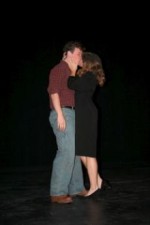Screaming, witches and time travel! OH MY!

Screams, shrieks, cries of terror, and pleas for salvation echoed throughout the newly renovated Casella Theater on Sept. 21 as the Castleton State College Theater Arts Department presented Arthur Millers “The Crucible.” On a stage with very few set pieces and plain lighting, Miller’s parable of the misery caused by the McCarthy anti-Communist hearings of the 1950’s was performed.
This interpretation chose to place the action of the play in 1953 instead of the original 1692, the inference for such a drastic change in setting can only be that the artistic vision of this show was driving towards making our society see a modern day witch hunt occurring now.
A directorial choice such as this time change was not only unwarranted, it was detrimental to the overall effect of the piece.
The language in “The Crucible” is not archaic, it is not in verse, or containing strange emphases on certain syllables, it is, however, dated. To see a man walk on stage in a costume that portrays the 1950’s very well, and to hear him speak with words that are strangely put together, temporarily takes one out of the moment. It is hard to focus on the true connections between actors when the language clashes so with the surroundings.
John Proctor (Dave Gabaree) our tragic hero in “The Crucible” carried the part well with striking moments of intensity that stole the stage and would unfortunately be undercut by a break in his stance, with his body going from stern and focused to almost floundering the next moment.
Elizabeth Proctor (Lauren Martin) was a joy to watch amidst all the yelling (and there was a lot of it) and she carried herself with quiet dignity and delivered many of her line in a low decibel that contained more power than any of the shouters in the cast.
There were many other notable appearances and characters that impacted the audience, even though they only had a handful of lines. For the most part these gems saved many scenes when the energy was seemingly forced to the edge of tolerance, or simply not there.
Much of the direction seemed to be focused at scaring the audience into attention, the level of yelling was briefly taken away by soft words from Abigail Williams (Christina Labarge) who exuded sensuality, wisdom, and viscous cunning, and whose voice contained all three. Another pleasure to watch was Francis Nurse (Matthew Howk), an old doddling man who seemed confused much of the time and softly shuffled around the stage.
In the chaos of the often melodramatic acting, these and a few other actors truly appeared to be the adults on stage with the children. These actors who did not succumb to the frantic yell-fest commanded attention in their honest portrayal, this is not to say that even they as well didn’t not slip up once in a while. One such instance occurred when John Proctor in a sporadic fit of anger pulls a large whip off the wall and cracks it against the stage. This outburst seemed there only because the actor was told to do it, spontaneous, not needed and confusing.
At the end of “The Crucible” we see the evolution of the masses gone awry, the blind fear of government, and the craze of witch hunting run its unfortunate course. The parallels from Miller’s play to the 1950’s is well documented. The choice to set the play in the 50’s so that we view its message in a modern context is insulting not only to the audience member who knows the show, but also to Arthur Miller, whose subtext is not limited to 1953 or 1692, but rather every age where there is dissent.
C-
Editor’s note: For more pictures from The Crucible, check out the Web Exclusive slideshow at www.castletonspartan.com





